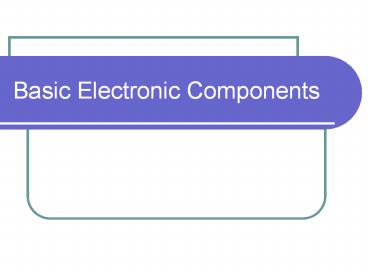Basic Electronic Components - PowerPoint PPT Presentation
1 / 28
Title:
Basic Electronic Components
Description:
Basic Electronic Components Crystals Equivalent Circuit to Crystal Crystal Schematic Symbol Piezoelectric Crystals Squeezing the crystal produces an EMF ... – PowerPoint PPT presentation
Number of Views:4725
Avg rating:3.0/5.0
Title: Basic Electronic Components
1
Basic Electronic Components
2
Crystals
3
Equivalent Circuit to Crystal
4
Crystal Schematic Symbol
5
Piezoelectric Crystals
- Squeezing the crystal produces an EMF
- Squeeze the x-axis and a voltage difference
occurs on the y-axis - Place a voltage difference on the y-axis and the
x-axis contracts or expands
6
Switches
7
Relays
- Relay
- Consists of two parts coil and switch
- Current flowing through the coil will create
magnetic field - A strong enough magnetic field will pull the
switch - When current stops, switch moves back into
original position - SPST Single Post, Single Throw
- SPDT Single Post, Double Throw three switch
positions
8
Light Bulb
9
Tube Diode
- Tube diodes have three elements
- FilamentHeats up cathode so it can donate
electrons easily - Anode (positively charged plate) emitter of
electrons - Cathode (negatively charged plate)collector of
electrons - Current only flows in one direction from anode to
cathode - When reverse biased, no current flow
10
Effect of Diode on AC voltage source
11
Diode plus capacitor
12
TriodeAddition of another element called the
grid
- Grid is a metallic mesh (holes to let electrons
flow through). - How many electrons flow through grid depends on
charge - Negatively charged grid repels electrons
- Positively charged grid attracts electrons
- The ratio of the voltage into a triode to the
voltage supplied by the triode is called the
gain (gainvoltage out/ voltage in)
13
Old School Cathode Ray Tube (CRT)
14
Structure of germanium (similar to silicon)
15
Ge doped with Arsenic (As)
Note the extra electron
16
Voltage applied to Ge(As)
17
Ge doped with Indium
Note missing electron
18
Voltage applied to Ge(In)
19
A PN junction
- Ge(In) Ge(As)
- Note more positive charge carriers on left than
right
20
Applying a positive voltage to the N side (called
reverse biased)
21
A forward biased PN junction
- Note that the behavior of a PN junction is
exactly like that of a diode - Current can only flow one way
22
Schematic Diagram of Diode
- Other diodes
- Light Emitting Diodes (LED)
- Give off light as current passes through them
- Dark when forward biased
23
How Transistors Work
24
Op-Amps Equivalent Circuit
Transistor Symbol
25
Chip Layouts for Op Amps
26
Schematic and Necessary Inputs to Op Amps
27
Inverting Amplifiers
- Output voltage is negative of input voltage
- Gain (G) is equal to
- G-R2/R1
- Inverting, unity amplifier when R2R1
- If we replace R2 with a capacitor circuit
becomes an integrator - Since G is now a function of w, then lower
frequencies are amplified with a greater than 1
gain - Called a low pass filter
- If we replace R1 with a capacitor-then lower
frequencies are attenuated - Called a high pass filter
- Sometimes called a differentiator
28
Non-inverting Amplifiers
- G 1 (R2/R1)































